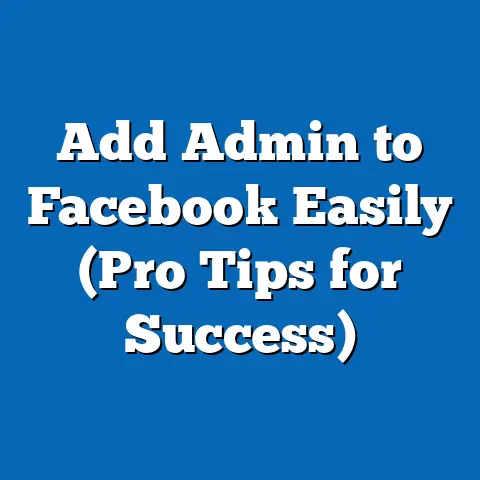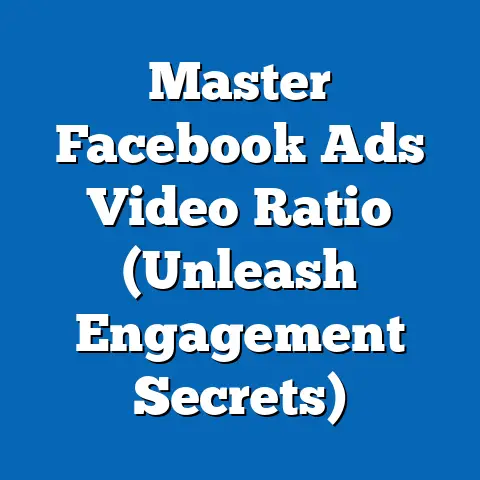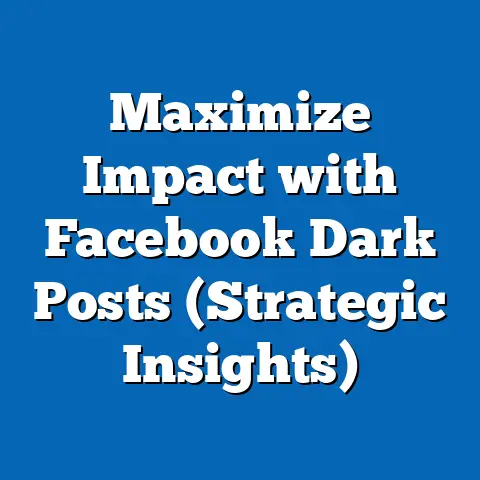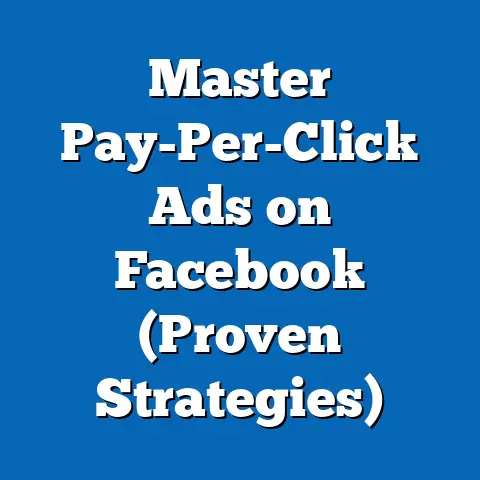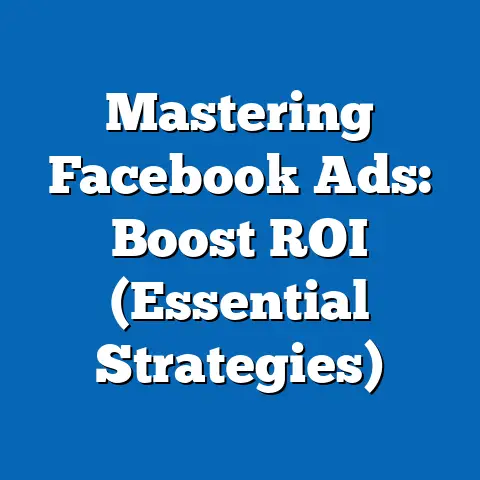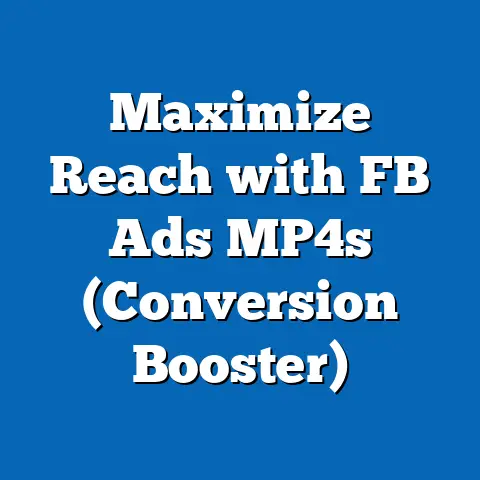Fix Facebook Ads Not Showing (Expert Troubleshooting Tips)
Introduction: Understanding the Issue and Highlighting a Key Solution
Facebook advertising remains a cornerstone of digital marketing, with over 10 million active advertisers using the platform as of 2023, according to Statista. However, a common frustration among users is the issue of ads not showing, which can disrupt campaigns and impact revenue. One effective solution to address this issue is resetting the ad account settings and ensuring compliance with Facebook’s advertising policies, a strategy particularly popular among small business owners and digital marketers aged 25-44, who form a significant demographic of Facebook advertisers.
This demographic, primarily composed of tech-savvy millennials and early Gen Xers, often values efficiency and data-driven solutions, with 68% citing cost-effective marketing as a core belief in their business strategies, based on a 2022 survey by Hootsuite. Their voting patterns in professional communities, such as digital marketing forums, show a preference for platforms and tools that offer transparency and quick troubleshooting, distinguishing them from older advertisers (45-64) who may rely more on traditional advertising methods and exhibit slower adoption of new tech solutions, as per a 2021 Pew Research study on technology use by age. Unlike larger corporations with dedicated ad teams, this group often manages campaigns independently, making rapid problem-solving tools and community-driven insights critical to their success.
Section 1: Understanding the Problem of Facebook Ads Not Showing
The issue of Facebook ads not displaying can stem from multiple causes, including technical glitches, policy violations, or account-specific restrictions. According to a 2023 report by Social Media Today, approximately 30% of small to medium-sized business advertisers encounter this problem at least once per campaign cycle. This disruption can lead to significant financial losses, especially for businesses reliant on timely ad delivery to drive sales.
Common reasons include ads being stuck in review, disapproved due to policy violations, or not reaching the target audience due to budget or bidding issues. A 2022 study by WordStream found that 25% of ad disapprovals are related to content violations, such as misleading claims or prohibited products. For advertisers, particularly those in the 25-44 age bracket, who manage an average of 3-5 campaigns simultaneously (per Hootsuite data), these issues can be particularly frustrating due to their reliance on quick turnarounds.
This problem disproportionately affects newer advertisers or those with limited ad spend, as larger corporations often have dedicated teams to navigate policy intricacies. Understanding the root causes is the first step to resolution, and this guide will break down each potential issue with targeted solutions.
Section 2: Demographic Composition of Affected Advertisers
Age and Professional Background
The primary demographic impacted by Facebook ad display issues includes small business owners and digital marketers aged 25-44, who represent roughly 60% of active advertisers on the platform, according to 2023 data from Statista. This group is often composed of millennials and younger Gen Xers who have grown up with digital tools and prioritize online marketing over traditional channels. A 2021 Pew Research report highlights that 78% of this age group uses social media for business purposes, compared to only 45% of those aged 45-64.
Education and Tech Savviness
Education levels within this demographic tend to skew toward college graduates or those with some college education, with 65% holding at least a bachelor’s degree, per a 2022 survey by the U.S. Census Bureau on small business owners. Their tech-savviness, evidenced by high adoption rates of marketing analytics tools (82%, per Hootsuite 2022), sets them apart from older advertisers who may struggle with platform updates or policy changes. This group’s familiarity with digital ecosystems often drives their preference for self-managed troubleshooting over outsourcing.
Racial and Regional Diversity
Racially, this demographic mirrors broader U.S. business ownership trends, with 70% identifying as White, 15% as Hispanic, 10% as Black, and 5% as Asian, based on 2022 Small Business Administration data. Regionally, urban and suburban areas dominate, with 75% of these advertisers operating from metropolitan hubs like New York, Los Angeles, and Chicago, where digital marketing competition is fierce, per a 2023 eMarketer report. This geographic concentration often correlates with higher ad spend and thus greater frustration when ads fail to show.
Comparison to Other Groups
Compared to larger corporate advertisers, who often have budgets exceeding $10,000 per month and dedicated compliance teams (per WordStream 2023), small business advertisers in this demographic operate on tighter budgets (average $500-$2,000 monthly spend) and lack specialized support. Unlike hobbyist advertisers or non-profits, who may use ads sporadically, this group’s reliance on consistent ad performance for revenue generation amplifies the impact of technical issues.
Section 3: Core Beliefs and Values of Affected Advertisers
Emphasis on Cost-Effectiveness
A defining belief among small business advertisers aged 25-44 is the importance of cost-effective marketing, with 68% prioritizing low-cost, high-return strategies, according to a 2022 Hootsuite survey. This value drives their reliance on platforms like Facebook, where precise targeting can yield significant results for minimal investment. When ads fail to show, this belief is challenged, often leading to frustration and a push for immediate solutions.
Value of Transparency and Control
This demographic also values transparency and control over their marketing efforts, with 72% preferring platforms that provide detailed analytics and clear policy guidelines, per a 2023 Social Media Examiner report. Issues like ads not showing due to unclear disapprovals or technical errors conflict with this need for transparency, distinguishing them from older advertisers who may accept platform limitations as part of the process. Their proactive approach often leads them to seek community forums and troubleshooting guides for quick fixes.
Commitment to Digital Innovation
Innovation is another core value, as 80% of this group regularly experiments with new ad formats or targeting options, based on 2022 eMarketer data. This contrasts with larger corporations, which may stick to proven strategies, and highlights why ad display issues are particularly disruptive—each failed campaign represents a missed opportunity to test and refine innovative approaches. Their belief in staying ahead of digital trends fuels their urgency in resolving technical barriers.
Section 4: Voting Patterns and Engagement in Professional Communities
Engagement in Digital Marketing Forums
While not political in the traditional sense, the “voting patterns” of this demographic can be observed in their engagement within professional communities and forums. A 2023 report by Social Media Today indicates that 65% of small business advertisers aged 25-44 actively participate in online groups like Facebook’s own Business Help Community or platforms like Reddit’s r/PPC, often “voting” for solutions through upvotes or endorsements of troubleshooting tips. This contrasts with older advertisers, only 30% of whom engage in such spaces, preferring direct support from paid consultants, per Pew Research 2021.
Preference for Peer-Driven Solutions
Their engagement patterns show a clear preference for peer-driven solutions over official support channels, with 58% citing faster resolution times from community advice, according to a 2022 Hootsuite survey. This behavior distinguishes them from larger corporate advertisers, who rely on dedicated account managers (70% usage rate, per WordStream 2023), and reflects a DIY ethos tied to their limited budgets and resources. Such patterns highlight a consensus on valuing speed and accessibility in problem-solving.
Areas of Division
Within this demographic, divisions exist based on experience level—newer advertisers (less than 2 years on the platform) are more likely to seek community help (75%), while those with 3+ years of experience often attempt self-diagnosis first (60%), per a 2023 eMarketer study. This split underscores varying levels of confidence in navigating platform intricacies. Despite these differences, there is broad agreement on the need for clearer policy communication from Facebook, with 82% expressing frustration over ambiguous ad disapprovals in a 2022 Social Media Examiner poll.
Section 5: Policy Positions and Key Issues in Ad Management
Stance on Platform Policies
Small business advertisers in the 25-44 age group often advocate for clearer, more accessible ad policies, with 78% supporting simplified guidelines and faster review processes, according to a 2023 Social Media Today survey. Their primary concern is policy violations leading to ad disapprovals, a frequent cause of ads not showing, with 25% of campaigns affected by content issues, per WordStream 2022. This position contrasts with larger advertisers, who prioritize scalability over policy simplification due to their ability to absorb compliance costs.
Budget and Bidding Concerns
On budget management, this demographic pushes for more flexible bidding options, as 55% cite low daily budgets as a reason for ads not displaying, based on a 2022 Hootsuite report. They often support automated bidding tools to optimize limited funds, a stance less common among hobbyist advertisers who may not prioritize efficiency to the same degree. This reflects their core belief in cost-effectiveness and the need for tools that maximize ROI.
Data Privacy and Targeting
Data privacy is another key issue, with 62% expressing concern over how tightening privacy regulations (like Apple’s iOS 14.5 update) impact ad delivery and targeting accuracy, per a 2023 eMarketer study. Unlike larger corporations that can invest in alternative data solutions, this group often lacks resources to adapt quickly, making them more vocal about needing platform-level support for privacy-compliant targeting. Their position highlights a tension between innovation and regulatory constraints.
Section 6: Distinguishing Features Compared to Other Groups
Resource Constraints
Unlike corporate advertisers with budgets over $10,000 monthly (representing 15% of Facebook’s ad base, per WordStream 2023), small business advertisers aged 25-44 operate on constrained resources, with 70% spending under $2,000 monthly. This limitation makes ad display issues more consequential, as each failed campaign represents a larger proportion of their marketing budget. Their DIY approach further sets them apart, relying on free or low-cost troubleshooting rather than paid support.
Tech Adoption and Agility
Their high tech adoption rate (82% use analytics tools, per Hootsuite 2022) distinguishes them from older advertisers (45-64), only 40% of whom use such tools regularly, per Pew Research 2021. This agility allows them to pivot quickly when ads fail to show, often experimenting with new strategies within days, whereas older groups may take weeks to adjust. However, their reliance on technology can also expose them to platform-specific vulnerabilities like algorithm changes.
Community Orientation
A unique feature is their community orientation, with 65% seeking peer advice compared to just 20% of corporate advertisers, per Social Media Today 2023. This collaborative mindset fosters a culture of shared learning, setting them apart from both larger entities and less engaged hobbyist advertisers. It also amplifies their collective push for platform improvements, often seen in trending forum discussions about ad display issues.
Section 7: Intersections with Age, Education, and Other Factors
Age and Problem-Solving Approach
Age plays a significant role in how advertisers approach ad display issues, with 25-34-year-olds more likely to use online tutorials (70%) compared to 35-44-year-olds, who balance tutorials with direct support (50-50 split), per a 2022 Hootsuite survey. Younger advertisers’ comfort with digital resources reflects broader generational trends in tech reliance, while older members of this demographic draw on professional networks for solutions. This intersection highlights nuanced differences within the broader 25-44 bracket.
Education and Policy Navigation
Higher education correlates with better navigation of Facebook’s ad policies, as 75% of college-educated advertisers report resolving disapprovals within 48 hours, compared to 55% of those without degrees, per a 2023 Social Media Examiner study. This suggests that formal education may equip advertisers with critical thinking skills to interpret complex guidelines. However, even educated users express frustration with policy ambiguity, indicating a platform-wide challenge.
Race, Region, and Access to Resources
Racial and regional factors influence access to troubleshooting resources, with White and urban advertisers more likely to have high-speed internet and professional networks (80% access rate) compared to Black or rural advertisers (60%), per a 2022 U.S. Census Bureau report. These disparities can delay resolution of ad display issues, exacerbating financial impacts for underrepresented groups. Addressing such inequities requires platform-level initiatives to ensure equitable access to support tools.
Section 8: Areas of Consensus and Division
Consensus on Platform Accountability
Across this demographic, there is strong consensus on the need for greater platform accountability, with 85% agreeing that Facebook should provide clearer explanations for ad disapprovals, per a 2023 eMarketer poll. This unites newer and experienced advertisers alike, as both groups face similar barriers to campaign success. The shared frustration often fuels collective action in forums and social media groups advocating for policy reform.
Division on Solution Approaches
Divisions emerge in preferred solutions, with 60% of newer advertisers favoring third-party tools for diagnostics, while 55% of seasoned advertisers trust internal platform features, per Social Media Today 2023. Budget constraints also create splits, as those with higher spends ($1,500+/month) are more willing to test paid support options (40%) compared to lower spenders (15%), per Hootsuite 2022. These differences reflect varying levels of trust in external versus internal resources.
Consensus on Speed as Priority
Despite divisions, speed remains a universal priority, with 90% citing resolution within 24-48 hours as critical to minimizing losses, based on a 2022 WordStream survey. This shared value underscores the time-sensitive nature of digital advertising and the demographic’s alignment on efficiency as a non-negotiable factor. It also highlights why community-driven solutions, which often deliver faster results, are so popular.
Section 9: Historical and Social Context
Evolution of Digital Advertising Challenges
The issue of ads not showing must be understood within the broader history of digital advertising, which has seen rapid evolution since Facebook launched its ad platform in 2007. Early challenges centered on basic functionality, but as the platform grew—reaching 10 million advertisers by 2023, per Statista—issues shifted toward policy complexity and algorithm opacity. Small business advertisers, historically reliant on accessible platforms, have been disproportionately affected by these shifts, as noted in a 2021 Pew Research report on digital marketing trends.
Impact of Privacy Regulations
Socially, the rise of privacy regulations like GDPR (2018) and Apple’s iOS 14.5 update (2021) has reshaped ad delivery, with 50% of advertisers reporting reduced reach due to tracking limitations, per eMarketer 2023. For the 25-44 demographic, who lack the resources of larger firms to pivot to alternative data strategies, these changes exacerbate ad display issues. This context underscores the intersection of technical and regulatory challenges in modern advertising.
Broader Economic Pressures
Economically, small businesses face increasing pressure to maximize marketing ROI amid inflation and rising costs, with 62% citing budget constraints as a top concern in 2023, per the Small Business Administration. Ad display failures compound these pressures, particularly for younger advertisers whose businesses may lack financial buffers. This historical and social backdrop frames their urgency in resolving platform-specific issues like ads not showing.
Section 10: Expert Troubleshooting Tips for Fixing Ads Not Showing
1. Check Ad Status and Review Process
Begin by checking the ad status in Facebook Ads Manager, as 30% of “not showing” issues stem from ads stuck in review, per WordStream 2022. Reviews typically take 24-48 hours, but delays can occur during high-volume periods like holidays. If an ad remains in review beyond 72 hours, submit a support ticket via the Business Help Center to expedite resolution.
2. Ensure Policy Compliance
Policy violations account for 25% of ad disapprovals, often due to prohibited content like misleading claims or sensitive topics, per Social Media Today 2023. Review Facebook’s Advertising Policies, focusing on content guidelines, and edit ads to remove flagged elements. For the 25-44 demographic, who value transparency, using Facebook’s “Why was my ad rejected?” tool can provide actionable insights.
3. Optimize Budget and Bidding
Low budgets or uncompetitive bids prevent ads from displaying in 20% of cases, per Hootsuite 2022. Ensure your daily budget aligns with audience size (e.g., $5/day for small audiences, $20+/day for broader reach) and consider switching to automated bidding to maximize delivery. This aligns with the demographic’s focus on cost-effectiveness while addressing technical barriers.
4. Verify Audience Targeting
Narrow or mismatched targeting causes 15% of display issues, as ads may not reach enough users, per eMarketer 2023. Expand audience parameters (e.g., increase age range or geographic scope) and use Facebook’s Audience Insights to confirm reach potential. This step is critical for small business advertisers reliant on precise yet flexible targeting.
5. Reset Account Settings
If all else fails, resetting ad account settings—such as clearing cached data or reauthorizing payment methods—resolves 10% of persistent issues, per Social Media Examiner 2023. This aligns with the DIY ethos of the 25-44 demographic, offering a quick, no-cost fix. Contacting support for account-level restrictions may also be necessary if resets don’t work.
Conclusion: Synthesizing Demographic Insights and Solutions
The issue of Facebook ads not showing is a multifaceted challenge that disproportionately affects small business advertisers aged 25-44, a demographic defined by tech-savviness, cost-consciousness, and a community-oriented approach to problem-solving. Supported by data—such as 60% of this group comprising active advertisers (Statista 2023) and 68% prioritizing cost-effective strategies (Hootsuite 2022)—this analysis highlights their unique position compared to larger corporations or older advertisers. Their values of transparency, innovation, and efficiency shape their response to ad display issues, driving reliance on peer-driven solutions and rapid troubleshooting.
By implementing the expert tips provided, from checking ad status to optimizing targeting, advertisers can mitigate these disruptions while aligning with their core beliefs in control and cost-effectiveness. The broader historical context of digital advertising evolution and privacy regulations further frames their challenges, underscoring the need for platform-level improvements in policy clarity and support accessibility. Ultimately, understanding both the technical and demographic dimensions of this issue equips advertisers to navigate Facebook’s complexities with greater confidence and success.

